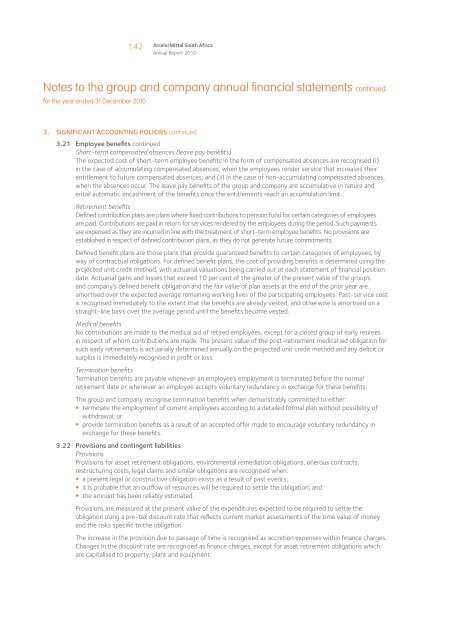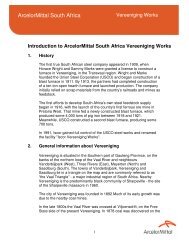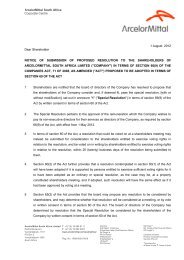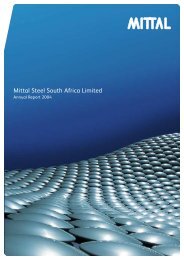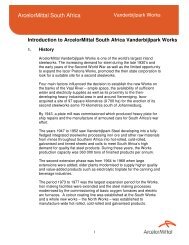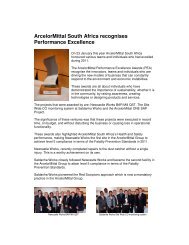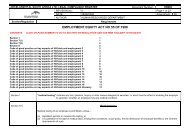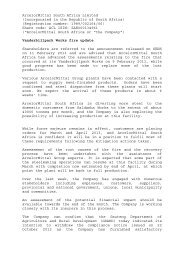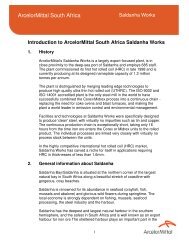bold spirit - ArcelorMittal South Africa
bold spirit - ArcelorMittal South Africa
bold spirit - ArcelorMittal South Africa
Create successful ePaper yourself
Turn your PDF publications into a flip-book with our unique Google optimized e-Paper software.
142<br />
<strong>ArcelorMittal</strong> <strong>South</strong> <strong>Africa</strong><br />
Annual Report 2010<br />
Notes to the group and company annual financial statements continued<br />
for the year ended 31 December 2010<br />
3. SIGNIFICANT ACCOUNTING POLICIES continued<br />
3.21 Employee benefits continued<br />
Short-term compensated absences (leave pay benefits)<br />
The expected cost of short-term employee benefits in the form of compensated absences are recognised (i)<br />
in the case of accumulating compensated absences, when the employees render service that increases their<br />
entitlement to future compensated absences; and (ii) in the case of non-accumulating compensated absences,<br />
when the absences occur. The leave pay benefits of the group and company are accumulative in nature and<br />
entail automatic encashment of the benefits once the entitlements reach an accumulation limit.<br />
Retirement benefits<br />
Defined contribution plans are plans where fixed contributions to pension fund for certain categories of employees<br />
are paid. Contributions are paid in return for services rendered by the employees during the period. Such payments<br />
are expensed as they are incurred in line with the treatment of short-term employee benefits. No provisions are<br />
established in respect of defined contribution plans, as they do not generate future commitments.<br />
Defined benefit plans are those plans that provide guaranteed benefits to certain categories of employees, by<br />
way of contractual obligations. For defined benefit plans, the cost of providing benefits is determined using the<br />
projected unit credit method, with actuarial valuations being carried out at each statement of financial position<br />
date. Actuarial gains and losses that exceed 10 per cent of the greater of the present value of the group’s<br />
and company’s defined benefit obligation and the fair value of plan assets at the end of the prior year are<br />
amortised over the expected average remaining working lives of the participating employees. Past-service cost<br />
is recognised immediately to the extent that the benefits are already vested, and otherwise is amortised on a<br />
straight-line basis over the average period until the benefits become vested.<br />
Medical benefits<br />
No contributions are made to the medical aid of retired employees, except for a closed group of early retirees<br />
in respect of whom contributions are made. The present value of the post-retirement medical aid obligation for<br />
such early retirements is actuarially determined annually on the projected unit credit method and any deficit or<br />
surplus is immediately recognised in profit or loss.<br />
Termination benefits<br />
Termination benefits are payable whenever an employee’s employment is terminated before the normal<br />
retirement date or whenever an employee accepts voluntary redundancy in exchange for these benefits.<br />
The group and company recognise termination benefits when demonstrably committed to either:<br />
• terminate the employment of current employees according to a detailed formal plan without possibility of<br />
withdrawal; or<br />
• provide termination benefits as a result of an accepted offer made to encourage voluntary redundancy in<br />
exchange for these benefits.<br />
3.22 Provisions and contingent liabilities<br />
Provisions<br />
Provisions for asset retirement obligations, environmental remediation obligations, onerous contracts,<br />
restructuring costs, legal claims and similar obligations are recognised when:<br />
• a present legal or constructive obligation exists as a result of past events;<br />
• it is probable that an outflow of resources will be required to settle the obligation; and<br />
• the amount has been reliably estimated.<br />
Provisions are measured at the present value of the expenditures expected to be required to settle the<br />
obligation using a pre-tax discount rate that reflects current market assessments of the time value of money<br />
and the risks specific to the obligation.<br />
The increase in the provision due to passage of time is recognised as accretion expenses within finance charges.<br />
Changes in the discount rate are recognised as finance charges, except for asset retirement obligations which<br />
are capitalised to property, plant and equipment.


